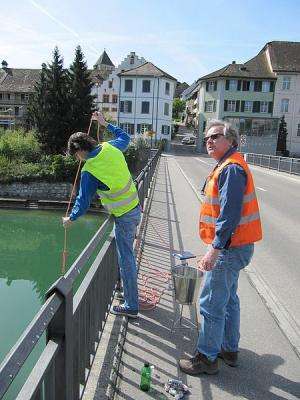Rhine water; linking young girls to sleeping pills (w/ Video)

Scientists from Delft University of Technology have become the first to link the presence of pharmaceutical residues in the Rhine to the demographic characteristics of people living along the Rhine. This knowledge could be used to develop a better way of dealing with the contamination of drinking water with pharmaceutical residues. The researchers have published their findings in the scientific journal Environmental Research Letters.
Contamination
Thirty million people depend on the Rhine for their drinking water, and 37 % of the drinking water in the Netherlands comes from rivers. Drinking water is to a certain extent contaminated with residues from prescription drugs (pharmaceuticals). It is therefore of great importance to improve our understanding of this process of contamination. To this end, researchers from TU Delft have collaborated with Het Waterlaboratorium (the Water Laboratory) to link water quality in the River Rhine to demographic data from the area. They hope that this will provide them with a detailed picture of the impact of local inhabitants on the river's water quality.
From the source to Lobith
They took water samples at 42 points along the river. These points were spaced at intervals of 20–30 kilometres. The researchers started near the source of the Rhine and ended just before Lobith, at the Dutch–German border. They then examined the concentrations of a large number of pharmaceuticals, including certain insomnia medications and anti-depressives. These pharmaceutical residues are passed into the sewer water through urine, eventually ending up in the Rhine.
"Young people and the elderly use very different pharmaceuticals in different quantities. Pharmaceutical usage also varies by nationality. These differences are so great that we were indeed able to detect most of these pharmaceuticals in the river water", explains researcher Rolf Hut of Delft University of Technology.
A first
This is the first time that the water from the Rhine has been studied in this way. Water authorities do monitor what is in the water, but the link to the residents in the surrounding areas is new. Hut would like to develop a predictive model that will make it possible to use demographic data to predict the composition of river water. This information would be of interest to water purification facilities, as even the best wastewater treatment plants have difficulty filtering pharmaceutical residues.
Girls and sleeping pills
One result from the study is as expected: the elderly use more medications than other demographic groups. In addition, the concentration of the anti-epilepsy drug carbamazepine corresponded closely to the presence of "older men". This result is consistent with Dutch studies regarding the number of prescriptions for this drug.
"But the correlations we have found do not necessarily indicate a direct link", notes Hut. "For example, the drug oxazepam (an insomnia medication) is highly correlated with 'girls (younger than 15 years of age)'. Given that oxazepam is almost never prescribed for children, it is unlikely that use of oxazepam by girls is the source. Nevertheless, it is clear that more of the insomnia medication oxazepam ends up in the river in areas with many young girls".
More information: Environ. Res. Lett. 8 044057 iopscience.iop.org/1748-9326/8/4/044057/article
Journal information: Environmental Research Letters
Provided by Delft University of Technology


















